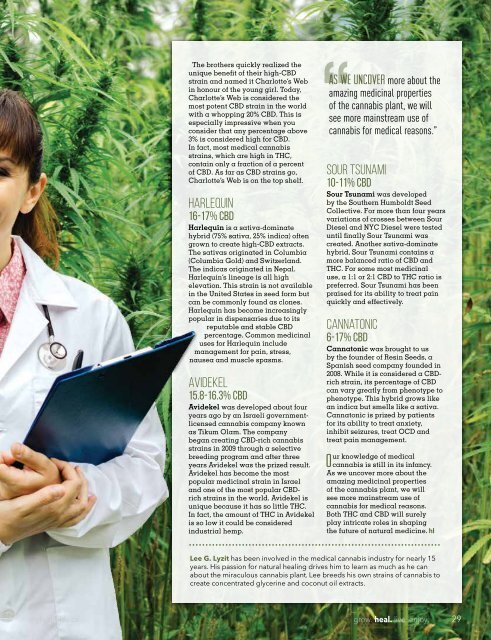Hydrolife Magazine June/July 2016 (CAN Edition)
In the new June/July edition of Hydrolife we explore how, rather than being a gateway, cannabis is actually reducing reliance on opiates used commonly for pain treatment. We also take a look at the many methods that can be employed for using cannabis for pain management. Our Ask a Nurse column provides helpful tips for those considering cannabis, and our writers have gone to great efforts to explain how various strains have different effects and qualities. So in this edition of Hydrolife we invite you to Grow, Live and Heal, but most of all, Enjoy!
In the new June/July edition of Hydrolife we explore how, rather than being a gateway, cannabis is actually reducing reliance on opiates used commonly for pain treatment. We also take a look at the many methods that can be employed for using cannabis for pain management. Our Ask a Nurse column provides helpful tips for those considering cannabis, and our writers have gone to great efforts to explain how various strains have different effects and qualities. So in this edition of Hydrolife we invite you to Grow, Live and Heal, but most of all, Enjoy!
You also want an ePaper? Increase the reach of your titles
YUMPU automatically turns print PDFs into web optimized ePapers that Google loves.
The brothers quickly realized the<br />
unique benefit of their high-CBD<br />
strain and named it Charlotte’s Web<br />
in honour of the young girl. Today,<br />
Charlotte’s Web is considered the<br />
most potent CBD strain in the world<br />
with a whopping 20% CBD. This is<br />
especially impressive when you<br />
consider that any percentage above<br />
3% is considered high for CBD.<br />
In fact, most medical cannabis<br />
strains, which are high in THC,<br />
contain only a fraction of a percent<br />
of CBD. As far as CBD strains go,<br />
Charlotte’s Web is on the top shelf.<br />
Harlequin<br />
16-17% CBD<br />
Harlequin is a sativa-dominate<br />
hybrid (75% sativa, 25% indica) often<br />
grown to create high-CBD extracts.<br />
The sativas originated in Columbia<br />
(Columbia Gold) and Switzerland.<br />
The indicas originated in Nepal.<br />
Harlequin’s lineage is all high<br />
elevation. This strain is not available<br />
in the United States in seed form but<br />
can be commonly found as clones.<br />
Harlequin has become increasingly<br />
popular in dispensaries due to its<br />
reputable and stable CBD<br />
percentage. Common medicinal<br />
uses for Harlequin include<br />
management for pain, stress,<br />
nausea and muscle spasms.<br />
Avidekel<br />
15.8-16.3% CBD<br />
Avidekel was developed about four<br />
years ago by an Israeli governmentlicensed<br />
cannabis company known<br />
as Tikum Olam. The company<br />
began creating CBD-rich cannabis<br />
strains in 2009 through a selective<br />
breeding program and after three<br />
years Avidekel was the prized result.<br />
Avidekel has become the most<br />
popular medicinal strain in Israel<br />
and one of the most popular CBDrich<br />
strains in the world. Avidekel is<br />
unique because it has so little THC.<br />
In fact, the amount of THC in Avidekel<br />
is so low it could be considered<br />
industrial hemp.<br />
“As we uncover more about the<br />
amazing medicinal properties<br />
of the cannabis plant, we will<br />
see more mainstream use of<br />
cannabis for medical reasons.”<br />
Sour Tsunami<br />
10-11% CBD<br />
Sour Tsunami was developed<br />
by the Southern Humboldt Seed<br />
Collective. For more than four years<br />
variations of crosses between Sour<br />
Diesel and NYC Diesel were tested<br />
until finally Sour Tsunami was<br />
created. Another sativa-dominate<br />
hybrid, Sour Tsunami contains a<br />
more balanced ratio of CBD and<br />
THC. For some most medicinal<br />
use, a 1:1 or 2:1 CBD to THC ratio is<br />
preferred. Sour Tsunami has been<br />
praised for its ability to treat pain<br />
quickly and effectively.<br />
Cannatonic<br />
6-17% CBD<br />
Cannatonic was brought to us<br />
by the founder of Resin Seeds, a<br />
Spanish seed company founded in<br />
2008. While it is considered a CBDrich<br />
strain, its percentage of CBD<br />
can vary greatly from phenotype to<br />
phenotype. This hybrid grows like<br />
an indica but smells like a sativa.<br />
Cannatonic is prized by patients<br />
for its ability to treat anxiety,<br />
inhibit seizures, treat OCD and<br />
treat pain management.<br />
Our knowledge of medical<br />
cannabis is still in its infancy.<br />
As we uncover more about the<br />
amazing medicinal properties<br />
of the cannabis plant, we will<br />
see more mainstream use of<br />
cannabis for medical reasons.<br />
Both THC and CBD will surely<br />
play intricate roles in shaping<br />
the future of natural medicine.<br />
Lee G. Lyzit has been involved in the medical cannabis industry for nearly 15<br />
years. His passion for natural healing drives him to learn as much as he can<br />
about the miraculous cannabis plant. Lee breeds his own strains of cannabis to<br />
create concentrated glycerine and coconut oil extracts.<br />
myhydrolife.ca grow. heal. live. enjoy. 29




![Hydrolife Magazine December 2017/January 2018 [CANADIAN EDITION]](https://img.yumpu.com/59790088/1/190x247/hydrolife-magazine-december-2017-january-2018-canadian-edition.jpg?quality=85)
![Hydrolife Magazine December 2017/January 2018 [USA EDITION]](https://img.yumpu.com/59790042/1/190x247/hydrolife-magazine-december-2017-january-2018-usa-edition.jpg?quality=85)
![Hydrolife Magazine October/November 2017 [Canada Edition]](https://img.yumpu.com/59493562/1/190x247/hydrolife-magazine-october-november-2017-canada-edition.jpg?quality=85)
![Hydrolife Magazine October/November 2017 [USA Edition]](https://img.yumpu.com/59493548/1/190x247/hydrolife-magazine-october-november-2017-usa-edition.jpg?quality=85)
![Hydrolife Magazine August/September 2017 [USA Edition]](https://img.yumpu.com/59236656/1/190x247/hydrolife-magazine-august-september-2017-usa-edition.jpg?quality=85)









